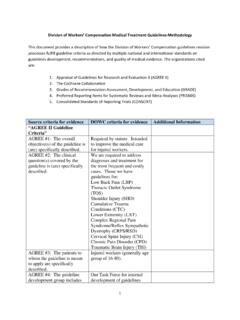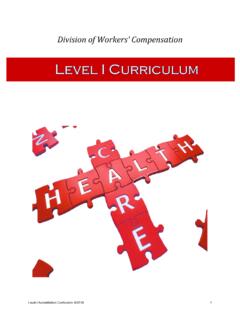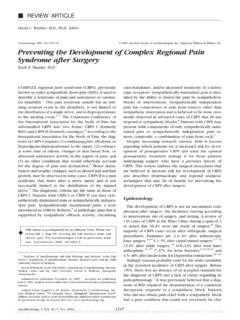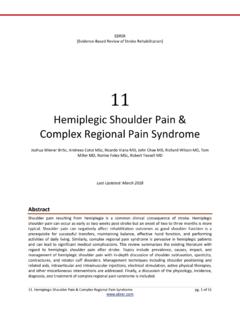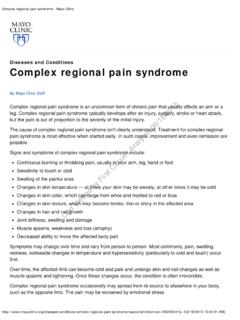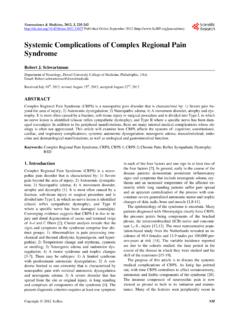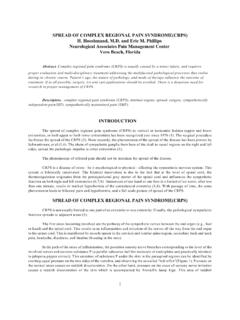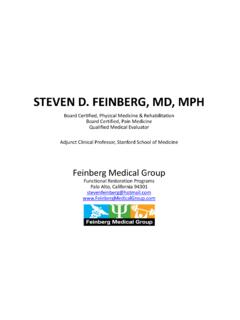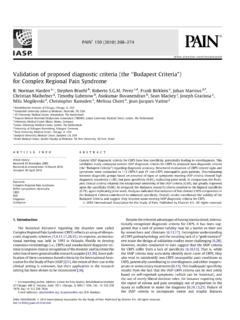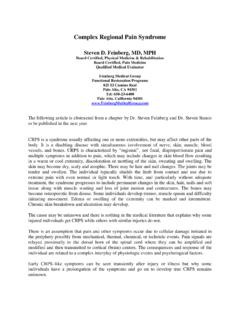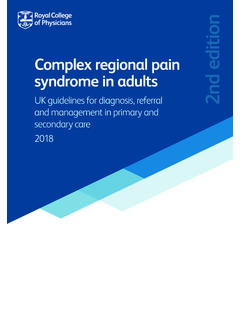Transcription of Complex Regional Pain Syndrome/ Reflex Sympathetic ...
1 RULE 17, EXHIBIT 7 Complex Regional pain syndrome / Reflex Sympathetic Dystrophy Medical Treatment Guideline Revised: 10/6/2017 Effective: 11/30/2017 Adopted: November 4, 1996 Effective: December 30, 1996 Revised: January 8, 1998 Effective: March 15, 1998 Revised: May 27, 2003 Effective: July 30, 2003 Revised: September 29, 2005 Effective: January 1, 2006 Revised: December 27, 2011 Effective: February 14, 2012 Presented by: DIVISION OF WORKERS' COMPENSATION TABLE OF CONTENTS Section Description Page A. INTRODUCTION .. 5 B. GENERAL GUIDELINE PRINCIPLES .. 6 1. APPLICATION OF GUIDELINES .. 6 2. EDUCATION .. 6 3. INFORMED DECISION MAKING .. 6 4. TREATMENT PARAMETER DURATION.
2 6 5. ACTIVE INTERVENTIONS .. 6 6. ACTIVE THERAPEUTIC EXERCISE PROGRAM .. 6 7. POSITIVE PATIENT RESPONSE .. 7 8. RE-EVALUATION OF TREATMENT NO LESS THAN EVERY 3 TO 4 WEEKS .. 7 9. SURGICAL INTERVENTIONS .. 7 10. SIX-MONTH TIME FRAME .. 7 11. 7 12. DELAYED RECOVERY .. 7 13. GUIDELINE RECOMMENDATIONS AND INCLUSION OF MEDICAL EVIDENCE .. 8 14. TREATMENT OF PRE-EXISTING CONDITIONS .. 8 C. INTRODUCTION TO Complex Regional pain syndrome .. 9 D. DEFINITIONS .. 10 1. AFTER 10 2. ALLODYNIA .. 10 3. CENTRAL pain .. 10 4. CENTRAL SENSITIZATION .. 10 5. DYSTONIA .. 10 6. HYPERALGESIA .. 10 7. HYPEREMIA .. 10 8. HYPERESTHESIA .. 10 9. HYPERPATHIA .. 10 10. HYPOESTHESIA .. 10 11.
3 pain BEHAVIOR .. 10 12. SUDOMOTOR CHANGES .. 10 13. SYMPATHETICALLY MAINTAINED pain (SMP) .. 11 14. TROPHIC CHANGES .. 11 15. VASOMOTOR CHANGES .. 11 E. INITIAL EVALUATION .. 12 1. HISTORY TAKING AND PHYSICAL EXAMINATION (HX & PE) .. 12 a. Medical 12 b. pain History .. 14 c. Medical Management History .. 14 d. Substance Use/Abuse .. 15 e. Other Factors Affecting Treatment Outcome .. 15 f. Physical Examination .. 15 F. OVERVIEW OF CARE FOR CRPS OR SYMPATHETICALLY MEDIATED pain .. 17 G. DIAGNOSTIC CRITERIA AND PROCEDURES .. 18 1. DIAGNOSIS OF CRPS .. 18 2. DIAGNOSTIC COMPONENTS OF CLINICAL CRPS .. 20 3. DIAGNOSTIC COMPONENTS OF CONFIRMED CRPS .. 21 4. SYMPATHETICALLY MAINTAINED pain (SMP).
4 22 5. NOT CRPS OR SMP .. 22 6. DIAGNOSTIC IMAGING .. 22 a. Plain Film Radiography .. 22 b. Triple Phase Bone Scan .. 22 7. INJECTIONS DIAGNOSTIC Sympathetic .. 23 a. Stellate Ganglion Block .. 24 b. Lumbar Sympathetic Block .. 24 c. Phentolamine Infusion Test .. 24 8. THERMOGRAPHY (INFRARED STRESS THERMOGRAPHY) .. 24 a. Cold Water Stress Test (Cold Pressor Test) .. 25 b. Warm Water Stress Test .. 25 c. Whole Body Thermal Stress .. 25 9. AUTONOMIC TEST BATTERY .. 25 a. Infrared Resting Skin Temperature (RST) .. 25 b. Resting Sweat Output (RSO) .. 25 c. Quantitative Sudomotor Axon Reflex Test (QSART) .. 25 10. OTHER DIAGNOSTIC TESTS NOT SPECIFIC FOR CRPS .. 26 a. Electrodiagnostic Procedures.
5 26 b. Laboratory Tests .. 26 c. Peripheral Blood Flow (Laser Doppler or Xenon Clearance Techniques) .. 27 11. PERSONALITY/ PSYCHOLOGICAL/PSYCHOSOCIAL EVALUATIONS FOR pain MANAGEMENT .. 27 12. SPECIAL TESTS .. 27 H. THERAPEUTIC PROCEDURES NON-OPERATIVE .. 28 1. ACUPUNCTURE .. 28 2. BIOFEEDBACK .. 29 3. COMPLEMENTARY MEDICINE .. 29 4. DISTURBANCES OF SLEEP .. 29 5. EDUCATION/INFORMED/SHARED DECISION MAKING .. 29 6. INJECTIONS THERAPEUTIC .. 31 a. Sympathetic Injections .. 31 b. Peripheral Nerve Blocks .. 32 c. Other Intravenous Medications and Regional Blocks .. 32 d. Continuous Brachial Plexus Infusions .. 33 e. Epidural 33 f. Ketamine: .. 33 7. INTERDISCIPLINARY REHABILITATION PROGRAMS.
6 34 a. Overview .. 34 b. Formal Interdisciplinary Rehabilitation Programs .. 37 c. Informal Interdisciplinary Rehabilitation Program .. 39 8. MEDICATIONS AND MEDICAL MANAGEMENT .. 41 a. General Chronic pain Medication Management .. 41 b. CRPS Specific Medication Management .. 44 c. CRPS-Specific Medications .. 45 d. Opioids .. 47 9. OPIOID ADDICTION TREATMENT .. 69 10. OPIOID/CHEMICAL TREATMENT PROGRAMS .. 73 11. ORTHOTICS/PROSTHETICS/EQUIPMENT .. 74 12. PERSONALITY/PSYCHOLOGICAL/PSYCHOSOCIAL/P SYCHIATRIC INTERVENTION .. 74 13. RESTRICTION OF ACTIVITIES .. 74 14. 75 15. THERAPY- ACTIVE .. 75 a. Activities of Daily Living (ADL) .. 77 b. Aquatic Therapy .. 77 c. Functional Activities.
7 78 d. Gait Training .. 78 e. Mirror Therapy - Graded Motor Imagery .. 79 f. Neuromuscular Re-education .. 79 g. Stress Loading .. 80 h. Therapeutic Exercise .. 80 i. Work Conditioning .. 84 j. Work Simulation .. 84 16. THERAPY PASSIVE .. 85 a. Continuous Passive Motion (CPM) .. 85 b. Desensitization .. 86 c. Fluidotherapy .. 86 d. Paraffin Bath .. 86 e. Superficial Heat Therapy .. 87 I. THERAPEUTIC PROCEDURES OPERATIVE .. 88 1. NEUROSTIMULATION .. 88 2. DORSAL ROOT GANGLION STIMULATOR .. 89 3. PERIPHERAL NERVE 92 4. INTRATHECAL DRUG DELIVERY .. 92 5. SYMPATHECTOMY .. 93 6. AMPUTATION .. 93 J. MAINTENANCE MANAGEMENT .. 94 1. FUNCTIONAL 94 2. VITAMIN C .. 94 3.
8 OPIOID MEDICATION MANAGEMENT .. 95 4. INJECTION THERAPY .. 96 a. Sympathetic Blocks .. 96 Complex Regional pain syndrome 5 DEPARTMENT OF LABOR AND EMPLOYMENT Division of Workers Compensation CCR 1101-3 RULE 17, EXHIBIT 7 Complex Regional pain syndrome / Reflex Sympathetic DYSTROPHY MEDICAL TREATMENT GUIDELINE A. INTRODUCTION This document has been prepared by the Colorado Department of Labor and Employment, Division of Workers Compensation (Division) and should be interpreted within the context of guidelines for physicians/providers treating individuals qualifying under Colorado s Workers Compensation Act as injured workers with Complex Regional pain syndrome (CRPS), formerly known as Reflex Sympathetic Dystrophy (RSD).
9 Although the primary purpose of this document is advisory and educational, these guidelines are enforceable under the Workers Compensation Rules of Procedure, 7 CCR 1101-3. The Division recognizes that acceptable medical practice may include deviations from these guidelines, as individual cases dictate. Therefore, these guidelines are not relevant as evidence of a provider s legal standard of professional care. To properly utilize this document, the reader should not skip nor overlook any sections. Complex Regional pain syndrome 6 B. GENERAL GUIDELINE PRINCIPLES The principles summarized in this section are key to the intended implementation of all Division of Workers Compensation medical treatment guidelines and critical to the reader s application of the guidelines in this document.
10 1. APPLICATION OF GUIDELINES The Division provides procedures to implement medical treatment guidelines and to foster communication to resolve disputes among the provider, payer and patient through the Workers Compensation Rules of Procedure. In lieu of more costly litigation, parties may wish to seek administrative dispute resolution services through the Division or the office of administrative courts. 2. EDUCATION Education of the patient and family, as well as the employer, insurer, policy makers, and the community, should be the primary emphasis in the treatment of chronic pain and disability. Currently, practitioners often think of education last, after medications, manual therapy, and surgery.
